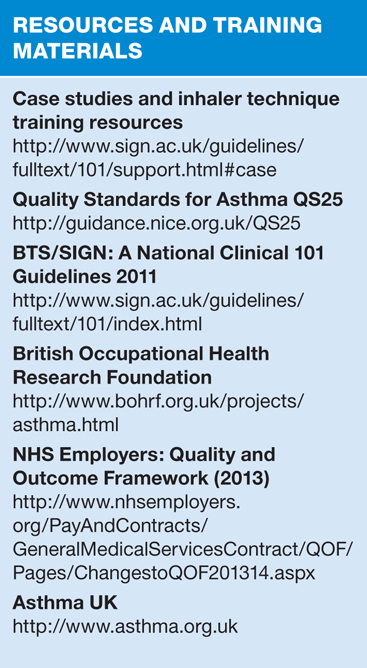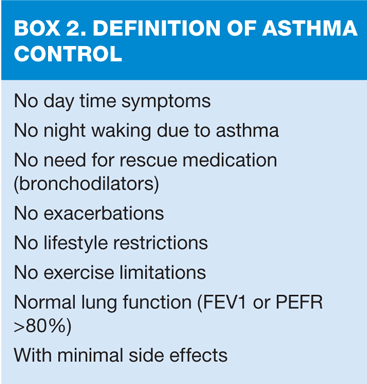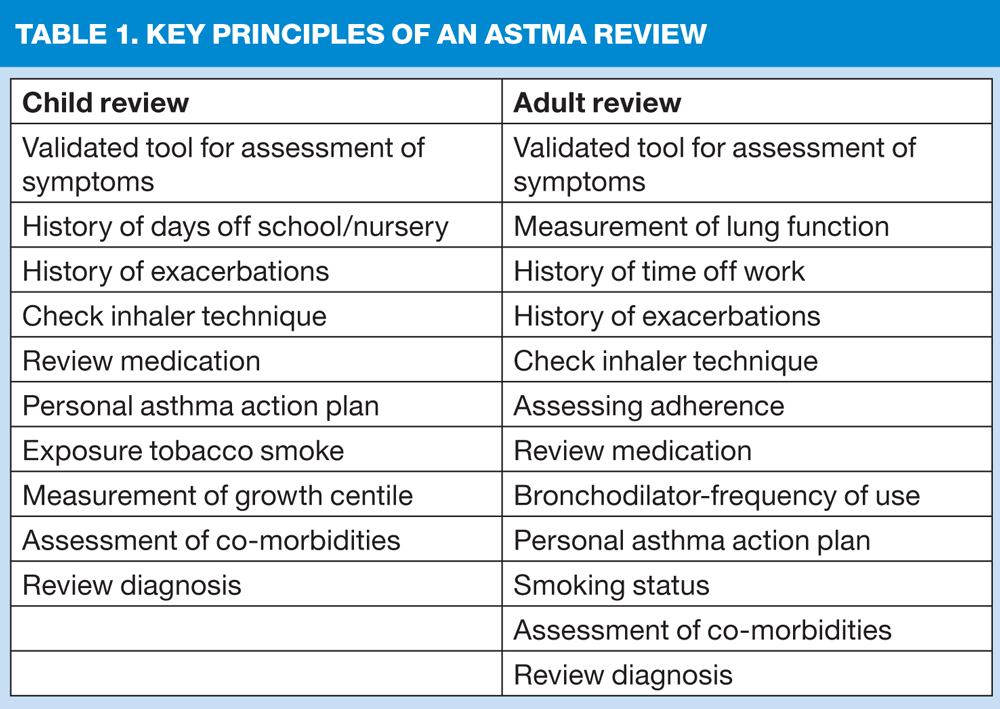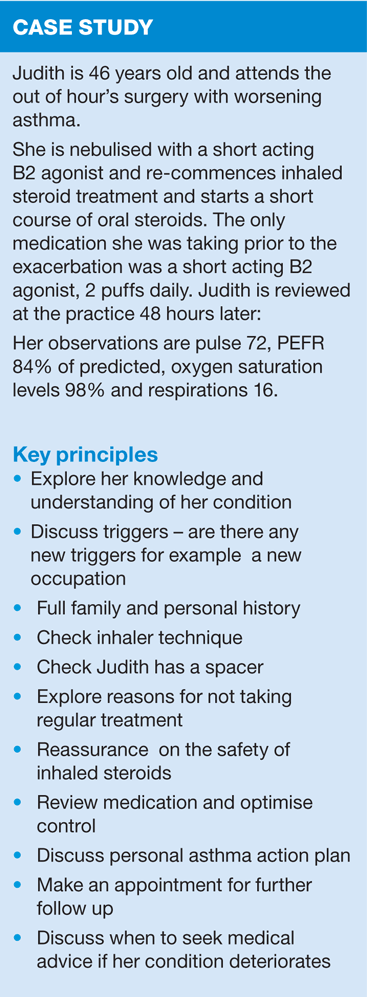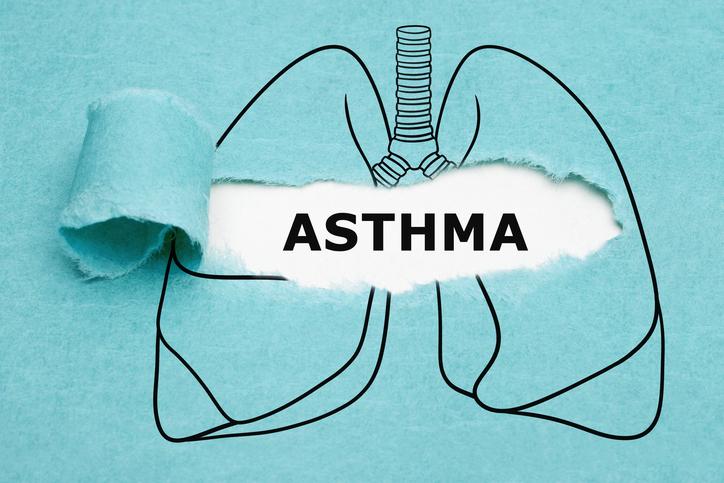
Setting a new benchmark for asthma care
Tricia Smith
Tricia Smith
RGN, RM BSc(Hons)
Registered Teacher, Practice nurse, Lecturer, GP Unit, Plymouth University
NICE has set out 11 new standards to improve the quality of asthma care, from initial diagnosis to the management of uncontrolled disease. Practice Nurse looks at what is required, particularly for patients who have an exacerbation
Asthma is a common and chronic inflammatory condition of the airways.1 It affects 5.4 million people in the United Kingdom (UK) from the very young, to the elderly.2 Prevalence over the last two decades has increased, especially in children, with the UK having the highest prevalence of the developed countries.3 The reasons for the increase in prevalence are not fully known, but it has been associated with the increase of allergy sensitisation and allergic conditions such as rhinitis and eczema.3 Asthma causes considerable morbidity and mortality and in 2009 there were 1,131 deaths, 12 of which were in children.4 It was estimated that 90% of these deaths could have been prevented, and that they were caused by poor management and inadequate use of preventive therapy.4 Asthma disease represents a huge burden on the NHS and on the quality of life of the individual with asthma.5
QUALITY STANDARDS
Following the publication of the Outcomes Strategy for Chronic Obstructive Pulmonary Disease and Asthma Care (2011),6 the National Institute for Health and Care Excellence (NICE) published new asthma quality standards.4 There are 11 standards in total with the overall aim of continuing to improve the quality of asthma care, focusing on early and accurate diagnosis, a structured approach to assessment and written personal plans to empower patients to self-manage more effectively.4 (Box 1) Research indicates that 75% of hospital admissions for patients with asthma could be avoided if patients were managed more effectively in primary care.6 NICE asthma quality standard10 recommends that all patients, following an exacerbation that has been seen in secondary care or attended out-of-hours services, should be reviewed in general practice within 2 working days of receiving treatment.4
Asthma patients contribute to a substantial workload in general practice and achieving these standards may initially appear quite daunting.7 However, reviewing a patient within this time frame will assess and monitor the patient’s recovery, optimise treatment and identify the causes of the exacerbation.
Standards 1 to 5 focus on improving the management of asthma care aiming to reduce exacerbation rates.4 Standards 6 to 11 focus on the management of uncontrolled asthma.4
These standards are the benchmark for high quality care, based on best practice for health care professionals and service users.4 This is to foster a cohesive approach to asthma services improving the quality, effectiveness and experience of care for patients with asthma.4
For the purpose of this article, the focus will be on standards 1 to 7, and standard 10 as these directly affect management of asthma in primary care, which is usually undertaken by the practice nurse.
The other standards are equally important but will involve other health care professionals such as general practitioners, specialist asthma nurses and respiratory consultants. (See Box 1, Quality Standards)
STATEMENT ONE
People with newly diagnosed asthma must have a diagnosis in line with BTS/SIGN guidance
There is no clear gold standard definition or diagnosis of asthma, and some of the symptoms are shared with other disorders.1 The common features of airway conditions are: cough, wheeze, chest tightness and breathlessness.1 However, the measurement of airflow limitation and reversibility will assist with diagnosis of asthma. The process of diagnosing asthma differs according to age. In most children over 5 years the diagnosis can be made on clinical findings and if unclear an objective test can be performed to support diagnosis.7 In adults, a comprehensive clinical history is essential, with objective measurement of airflow.
BTS/SIGN Guidance 101 states ‘…measurement of airflow limitation, its reversibility and its variability is considered critical in establishing a clear diagnosis of asthma.’
Spirometry is the preferred method of measurement of airflow for the initial diagnosis.7 Peak expiratory flow rate (PEFR) monitoring is more suited once a diagnosis of asthma has been established.7 Clear documentation on how the initial diagnosis was made is key to manage these patients effectively.4 Reviewing symptoms is a continuous process and will ensure an accurate diagnosis has been made and treatment is appropriate.7
STATEMENT 2
Adults who have recently developed asthma are assessed for causes linked to their place of work
Occupational asthma is often missed or misdiagnosed and it affects at least one in six of adults of working age.8 Occupational asthma should be considered if the symptoms of airflow limitation improve on non-working days or when away on holiday, especially in high risk occupations.7 The guidelines recommend recording PEFR measurements every 2 hours during the day and for least 4 weeks duration, from waking to sleeping times, and on starting and stopping work.7 If an early diagnosis is made and the specific triggers are removed, prognosis is improved.8 Further information can be obtained from www.occupationalasthma.com.
STATEMENT 3
People with asthma receive a written plan with details of how their asthma will be managed
Inadequate self-management is a major cause of asthma related morbidity.9 Patient education is an essential component of asthma care and engaging patients in the decision making will support self-management and patient independence.6 Health care professionals should explore the patient’s knowledge and understanding of the condition and tailor the education to their individual needs.10 A written personal asthma action plan has been proven to be an effective method in improving the quality of life for people with asthma; however the number of people who are offered written plans is low.7
Asthma UK maintains ‘patients who have a self-management plan are four times less likely to be admitted to hospital’.9
A personal plan should include how to recognise worsening symptoms, how to step up or down medications and when to seek medical advice.7 Personal asthma action plans are available from Asthma UK.
STATEMENT 4
People with asthma are given training in using their inhaler before they start a new inhaler treatment
Inhaler medications are the cornerstone of asthma therapy and to optimise control they should be used correctly. However, poor inhaler technique is a common problem and may lead to suboptimal control, which may result in an unnecessary increase of medication, or a hospital admission.7 Asthma emergencies cost the NHS £61 million a year and approximately 75% of these admissions would be avoidable if managed more effectively in primary care.9 Health care professionals need to ensure they are appropriately trained in inhaler technique, to enable them to assess, teach and reinforce patients’ techniques.7
BTS/SIGN Guidance 101 states ‘…inhaled medications should only be prescribed to patients after they have received training in the use of the device and have demonstrated satisfactory technique’.7
Poor technique reduces the efficiency of the medication, thereby increasing waste.10 Inhaler technique should be regularly assessed to ensure the maximum amount of medication is deposited in the lungs, optimising asthma control with the minimal amount of medication.11
STATEMENT 5
People with asthma have a review of their asthma and its management at least once a year
An annual review is part of the Quality and Outcomes Framework (QOF) for asthma management, although it is an optional incentive programme.12 The common themes for a good structured review include assessing symptoms, PEFR levels, inhaler technique, current medications and the promotion of self-management.7 A structured approach is associated with improved lung function and quality of life, reduced exacerbation rates and reduction of days lost from normal activity.7
It is evident that a significant number of people with asthma do not attend asthma reviews; therefore practices may need more innovative ways to review their asthma patients. Texting patients with the option of a telephone consultation may be more convenient for patients who are well controlled. There are also increasing numbers of pharmacists who have been trained to undertake asthma medicine use reviews (MURs) as part of their service to improve continuity of asthma care.10 (See Table 1 for key principles of an asthma review)
STATEMENTS 6 and 7
People with asthma who have symptoms have an assessment of how well their asthma is controlled; People with asthma who go to see a healthcare professional because their symptoms have worsened have their symptoms measured at the time of the appointment
Patients attending with respiratory symptoms in general practice should be assessed using a validated tool to identify the level of asthma control.4 This will help to manage these patients more effectively and to reduce exacerbation rates. There are various validated tools available:4
- Royal College of Physicians ‘Three questions’
- Asthma control questionnaire
- Asthma control test – paediatric asthma control test
- Mini quality of life questionnaire – paediatric quality of life questionnaire
These tools are used according to age of the patient and in conjunction with at least one lung function test, spirometry or PEFR to identify what further action is required.7 Prompt intervention may prevent patients’ symptoms worsening and improve their asthma control. When a patient presents with worsening asthma in general practice it is essential to assess the severity of symptoms immediately. Accurate measurements are essential to identify the severity of the exacerbation and to initiate the appropriate treatment promptly.6 These patients will also need a full assessment and review of inhaler technique, medications and their personal plan.
(See box 2 for definition of good asthma control)
STATEMENT 10
People who received treatment in hospital or through out- of-hours services for a sudden worsening of their asthma see a healthcare professional in their own GP practice within two working days of treatment
An asthma exacerbation is defined as an acute deterioration in lung function.13 However, contrary to belief most exacerbations do not develop suddenly but with a gradual increase of symptoms and lung deterioration over 6 hours or more.7 If patients can recognise an increase of symptoms and self-administer prompt treatment this can reduce the risk of exacerbation occurring.4 Health care professionals discharging patients from secondary care following an asthma exacerbation must ensure the patient’s symptoms are suitable for home management and that they are on reducing doses of B2 agonists.7 If a patient’s PEFR is < 75% of best or predicted, they are more likely to have relapses and require re-hospitalisation.7 Assessing a patient 48 hours following discharge is essential not only to reduce morbidity but also the risk of relapsing. A comprehensive history needs to be taken to identify the reasons for the exacerbation, together with a full assessment and medication review, and with adjustments according to the patient’s condition.14 The action plan should be reinforced and the patient encouraged to seek medical help promptly if their condition deteriorates.
Reviewing patients within two working days following an asthma exacerbation will be challenging for general practice. The majority of practice nurses will have the skills to manage these patients but the difficulty will be releasing practice nurse time for these additional consultations. This may involve reviewing the practice nurse’s current workload and using the practice nurse’s time more efficiently, through maximising skill mix and delegating non nursing roles to other members of the team.
Practices will need to develop robust systems to accommodate these patients, liaising with secondary care and out-of-hours services where there have been asthma-related admissions. This could be achieved by having a named nurse in the practice with a special interest in respiratory medicine who can be notified of these patients when they are discharged.
Practices will also have to ensure that same day appointments are available, by only releasing some appointments on the day or by holding slots for urgent appointments so these patients can be seen within the recommended timeframe. It is essential that all reception staff are also made aware that patients with asthma must be seen within 48 hours of discharge.
Practices may indicate they do not have capacity, but now that GPs are responsible for commissioning services for patients, they are more likely to perceive that preventing hospital admissions avoids both financial and human costs. NHS innovation has developed a programme to support general practice to assist with streamlining practice and efficiency without compromising quality of services or patient care.15
CONCLUSION
The overall aim of the asthma quality standards is to improve the management of patients with asthma to enable them to be symptom free, on the minimal amount of medication and to lead normal active lives.1 Together with BTS/SIGN guidelines7 they set a target for evidence based excellence in asthma care and equity of standards across the UK.
REFERENCES
1. Global Initiative for Asthma (2012), Pocket Guide for Asthma Management and Prevention http://www.ginasthma.org/documents/1
2. Global Initiative for Asthma(2012): Global Strategy for Asthma Management and Prevention
http://www.ginasthma.org/documents/4
3. The Global Burden of Asthma (2006) http://journal.publications.chestnet.org/article.aspex?articleid=1210781
4. National Institute of Health and Care Excellence: Quality Standards for Asthma (2013)
http://guidance.nice.org.uk/QS25
5. Ministers Launch National Strategy to Transform Respiratory Care, Practice Nurse
(2011) page 6 Vol 41
6. Department of Health (2011) The Outcomes Strategy for Chronic Obstructive Pulmonary Disease and Asthma in England
7. British Thoracic Society and Scottish Intercollegiate Guidelines Network: A National Clinical Guidelines 101 (2011) http://www.sign.ac.uk/guidelines/fulltext/101/index.html
8. British Occupational Health Research Founded, (2013) http://www.bohrf.org.uk/projects/asthma.html
9. Asthma UK (2012) http://www.asthma.org.uk/asthma-facts-and-statistics
10.National Institute of Clinical Excellence: Medicines and Prescribing Centre (2013)
11. Brocklebank D, Ram F, Wright J, Barry P, Cates C, Davies L, Douglas G, Muers M, Smith D, White J. (2001) Comparison of the effectiveness of inhaler devices in asthma and Chronic obstructive airways disease: a systematic review of the literature Health Technol 5(26):1-149.
12. NHS Employers: Quality and Outcome Framework (2013)
13. Aaron Chidekel and Peter S. Marshall (2010) Acute Asthma Exacerbations, Journal of Asthma and Allergy Educators Vol 1 N02 pp71-74
14. O Byrne P.M.(2011) Therapeutic Strategies to reduce asthma exacerbations: Institute of Respiratory Health, Vol 128 Issue 2 pp257-263
15. NHS Innovation and improvement http://www.institute.nhs.uk/general/general/primary_care.html
Related articles
View all Articles
